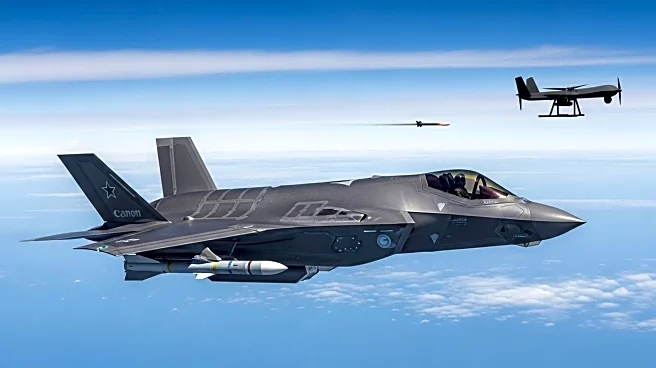What is the story about?
What's Happening?
The Royal Netherlands Air Force has achieved a significant milestone with its F-35A fighter jet, marking the first confirmed combat kill of a Russian drone by a NATO-operated fifth-generation aircraft. The incident occurred during a mission in Poland, where the Dutch F-35, tail number F-027 from the 313th Squadron, successfully downed a Russian drone. This event was highlighted by a photo released by the Dutch Ministry of Defense, showing the aircraft with a 'kill mark' symbol on its fuselage, indicating the successful engagement. The Dutch Defense Minister, Ruben Brekelmans, emphasized the importance of this operation, stating that Russia's aggressive actions continue to pose a threat, and the deployment of F-35s in Poland underscores the Netherlands' commitment to NATO's collective defense mission.
Why It's Important?
This development is crucial as it demonstrates NATO's capability to counter Russian aerial threats using advanced technology like the F-35 fighter jet. The successful engagement of a Russian drone by a NATO member highlights the alliance's readiness to protect its eastern borders, which are considered vital for collective security. The operation also serves as a deterrent against further incursions by Russian drones, reinforcing NATO's strategic presence in Eastern Europe. The Netherlands' involvement in these operations showcases its commitment to supporting allies and maintaining regional stability, which is essential for the security of Europe and the broader international community.
What's Next?
The Dutch F-35 fighters are scheduled to remain stationed in Poland until December 1 as part of NATO's ongoing defense mission. This deployment is expected to involve further operations to safeguard Polish airspace and deter Russian aggression. The continued presence of NATO forces in the region may prompt diplomatic responses from Russia, potentially influencing future military engagements and geopolitical dynamics. Stakeholders, including NATO member states, will likely monitor the situation closely to assess the effectiveness of these defense measures and adjust strategies accordingly.
Beyond the Headlines
The incident raises broader questions about the evolving nature of aerial warfare and the role of advanced fighter jets in modern military strategy. The use of fifth-generation aircraft like the F-35 in combat operations against drones signifies a shift in defense tactics, emphasizing technological superiority and precision. This development may influence future military procurement decisions and the strategic deployment of advanced aircraft in conflict zones, impacting defense policies and international relations.
AI Generated Content
Do you find this article useful?
















